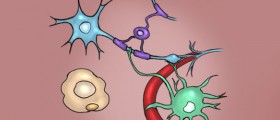
Neurons allow mutual communication between our brain and body. We have to learn the basics about neurons in order to completely understand how this process of communication is functioning. Neurons are the basic cells that build our central and peripheral nervous systems. Central nervous system includes brain and spinal cord, while peripheral stands for nerves in all others parts of the body such as eyes, skin, ears and all other senses. This means that with the help of these peripheral nerves we are able to realize what is going on in our surroundings, but only when the impulses from the nerves come to the centers in the brain.
Structure of a neuron
A neuron consists of three different parts and each neuron has cell body, one axon and more dendrites. Body of the neuron cells is the same as the body of other cells, which means that it has cytoplasm, mitochondria and other organelles and nucleus. The membrane is somewhat different in neuron cells from the membranes of the other cells in our organism, because it is specifically designed so that nerve cells could communicate. Axon is the part of the neuron that goes from the cell body, it can be long from couple of millimeters to a meter, it is protected with myelin and it transfers information from the cell body to nerve cells, or other cells in our organism. Dendrite is much shorter than axon and its function is to transfer information in the opposite directions, from another neuron to body cell.
Types of neurons
We distinguish three different types of nerve cells such as afferent or sensory, efferent or motor neurons and interneurons. The messages between neurons are transferred with the help of neurotransmitters that are in the synaptic space (space where two neurons are connecting). Afferent and efferent neurons communicate thanks to interneurons. There is one more classification of nerve cells and it distinguishes unipolar, bipolar and multipolar neurons. Unipolar nerve cells have one extend that is later divided in two and this extend is at the same time axon and dendrite. Bipolar have two extends that have specific functions, one is axon and the other is dendrite. Multipolar neurons have more extends of which one is axon and the others are dendrites. These neurons are allowing our muscles to receive messages from CNS. This is only an introduction on how our nerves function and it probably already seems complicated and makes you think about how much our body is complicated, and yet so perfectly structured.















Your thoughts on this
Loading...